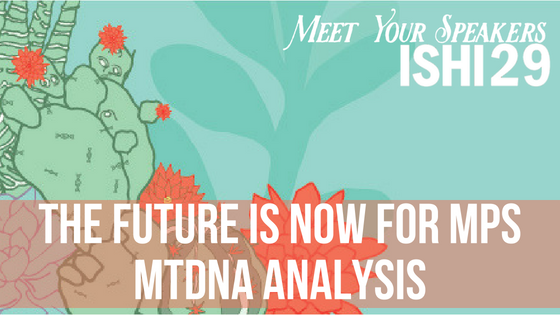Are you wondering what role MPS plays in forensic mtDNA analysis? Would you like to learn what systems are currently available for forensic MPS mtDNA analysis? Does the thought of validating and implementing MPS in your lab leave you anxious?
In their workshop at ISHI 29, Mitchell Holland of Penn State University and Michael Brandhagen of the FBI Laboratory will bring together a panel of experts to educate the community on the availability of complete systems for MPS analysis of mtDNA; including enrichment approaches, library preparation methods, instrument choices, and analysis software solutions.
We recently interviewed the panel, and they shared how combining mtDNA with MPS make mtDNA more accessible, the advantages and disadvantages of mtDNA analysis using MPS compared to currently employed methods, and how they foresee this impacting the forensic community.
Hi all! First I’d like to thank you for hosting a workshop on MPS mtDNA analysis. MPS continues to be a hot topic, and I know attendees will gain a lot of knowledge from this workshop.
Do the overall mtDNA results generated using MPS differ from traditional methods?
No, the final result will still be an mtDNA sequence profile (haplotype) listing the variants that differ from the rCRS (reference genome). While Sanger sequencing is a qualitative-based analysis, an MPS approach allows for quantitative analysis of each nucleotide position. Therefore, MPS allows for the routine reporting of heteroplasmic sites, enhancing the discrimination potential of the testing method.
How will combining mtDNA with MPS make mtDNA more accessible rather than a specialty?
The availability of kits and software to perform MPS-based mtDNA analysis immediately makes the testing method more accessible. Currently, mtDNA laboratories are forced to use custom-made amplification approaches prior to Sanger sequencing. Commercial amplification kits are available for both control region and whole mtGenome amplification for MPS analysis.
Bringing MPS online for mtDNA analysis will better prepare laboratories to adopt an MPS approach for STR and/or SNP analysis. For those laboratories already validating MPS analysis of STRs and/or SNPs, the implementation of mtDNA analysis is relatively straightforward.
For those laboratories with high throughput needs, MPS is definitely an advantage, and more cost effective.
How do you think mtDNA through MPS will impact the forensic community?
Acceptance of MPS technology in court should be easier since mtDNA is already a sequence-based approach. Once the method is accepted then it should be easier to bring STR and SNP-based analysis into court.
MPS makes mtDNA analysis a more accessible method for forensic laboratories. Casework will be positively impacted due to the increased sensitivity and quantitative analysis, along with the increased discriminatory power, especially when applied to the entire mtGenome.
Do you believe transitioning to MPS through mtDNA will be easier than traditional STRs? If so, why?
Yes, the sequencing paradigm is already in place for mtDNA. The only difference is the actual sequencing methodology. With STRs, the paradigm will change from length-based to sequence & length-based. In general, sequence analysis of STRs will be much more complicated than mtDNA sequence analysis.
What are the advantages of mtDNA analysis using MPS compared to currently employed methods? Any disadvantages?
Advantages:
- has the capability to generate larger, more informative data sets with far greater throughput
- workflow for mtGenome analysis is highly simplified compared to Sanger sequencing
- overall lower cost per nucleotide than traditional capillary electrophoresis-based methods when employing a high throughout approach
- can extend the lower limits of sample quality from which probative DNA data can be recovered; including highly degraded samples
Disadvantages:
- will increase the time for sequencing a small number of samples; currently one sample can be run in ~24hrs, if needed
- cost benefit only achievable when multiple samples are sequenced at the same time
Is it necessary for an attendee to have prior experience in either mtDNA or MPS in order to participate in this workshop?
Knowledge of DNA sequencing, in general, would be useful. A crash course on MPS and mtDNA analysis will be provided in the first presentation of the workshop. The three journal articles listed below (authored by the speakers) would be helpful in preparing participants for the workshop.
Thank you all for your insight! We can’t wait for the workshop!
WOULD YOU LIKE TO SEE MORE ARTICLES LIKE THIS? SUBSCRIBE TO THE ISHI BLOG BELOW!


